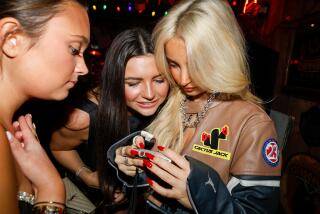Childhood Fears Reflect Adult Anxieties
Bad dogs. The wrong clothes. Bigger kids. Drug dealers. Parents dying. Or divorcing. Nuclear war. Having sex. Not having sex.
How did childhood and adolescence ever get the reputation of being carefree years?
“These kids,” sighs Anna Dotson, a guidance counselor at a Baltimore elementary school, “have a lot they’re confronting.”
While the worries of youth seem to pale next to adult concerns like mortgages and marriages, they’re just as real and just as monumental from a kid’s-eye view of the world, experts say.
Some Substitutions
In some ways, children’s fears have changed over the years. Substitute today’s worries about crack dealers and AIDS for yesterday’s worries about war and the Depression. But, mainly, children have always had to face the same sort of bogeymen, whatever their current incarnations.
“Life changes,” says Leon Rosenberg, Ph.D., a child psychologist at the Johns Hopkins Hospital Children’s Center in Baltimore. “Children before never knew to be afraid of smoking, for example. But children have always worried about threats to their parents and, now, if their parents smoke, they worry that they’re going to die.
“With young children in general, the fears really don’t change much. The younger child has fears of unknown things, bad things. For a 4- or 5-year-old, it’s monsters; for a 6- or 7-year-old, it’s Freddy Krueger. He may know it’s just a movie, but it embodies things that frighten him. It’s typical for a normal child to sort of have vague fears of monsters.
‘Aware at That Age’
“By 7, 8, 9 years old, there’s a tendency to get nervous about strangers, bad people, fire, because they’re more aware at that age of things happening in the neighborhood, the community,” says Rosenberg. “They’ll say, ‘I can’t sleep because there are robbers in the house.’ It will occur more intensely if there’s been a robbery in the neighborhood. Those are common fears at the time.”
A little bit of worrying is normal--and, in fact, worrying about a fear can help ease it.
“A certain amount of anxiety is salutary,” says Dr. John Goldenring, a California child psychiatrist who has studied children’s fears. “It appears that those who have dealt with their fears are better off than those who haven’t.”
But when does a healthy anxiety turn unhealthy?
“A child shouldn’t be spending any significant amount of energy worrying about it,” says Rosenberg. “With a fear of robbers, for example, maybe they can’t fall asleep right away, or when twilight comes around they might be scared. But they shouldn’t worry about it during the day. If it’s interrupting the child’s play during the day, something’s wrong. There’s too much anxiety in the home.”
Often, he says, children’s fears are a reflection of their parents’ anxiety levels. “That’s where they get their security,” he says. “If they see parents fall apart, 8-year-olds will fall apart.”
Parents often find themselves caught between keeping their children safe from the dangers of the world and making them fearful of every new person and everything outside their doorstep.
‘World’s Not Trustworthy’
“You don’t want to frighten the child, but you don’t want them to trust the world--because the world’s not trustworthy,” says Judy Estes, a mother of two. “I have to consciously guard against overreacting.
“I remember roaming the woods when I was a child,” says Estes, whose children are 2- and 6-years-old. “My daughter understands she can’t do that.”
Parents can make children wary of outside dangers without frightening them by explaining things in a “matter-of-fact, relaxed way,” says Rosenberg.
“It depends on how upset you get,” he says. “You should tell them, ‘I don’t want you talking to strangers. Most are good, but there are a couple of weirdos out there. If a stranger comes up to talk to you, walk away. If a stranger comes up to you and says your mommy sent me to get you, tell them I’ll never send a stranger to get you.’
“In the beginning, kids will get a little frightened” by these discussions, he says. “But you make it clear to them, and you remain firm and calm.”
Signs of Anxiety
Often, children won’t come out and say what they’re afraid of and, instead, will exhibit anxiety in other ways--refusing to go to school, or acting up at home or in the classroom. In fact, teachers and counselors often are the first to realize that a child is suffering from unresolved fears because that’s often where problems first crop up.
Sometimes, school itself can present a multitude of worries.
Shelia Davis, a guidance counselor at a Baltimore middle school in the midst of an impoverished, troubled neighborhood, says her charges often confront fears that more middle-class children never face.
She’s had students who got pregnant and were told by a relative, “Good, we need another check anyway”; students who have to feed and dress and get their younger siblings to school before they can get themselves off to class; students who don’t have breakfast before school or anything to wear.
“You cannot teach somebody something if they’re hungry,” she says. “Or if they don’t have something to wear. They worry, if I wear the same thing to school tomorrow, will everyone make fun of me? You think at that young of an age, they wouldn’t think they would worry about clothes, but they do.
“They worry, are they going to get beat up on the way home?” she says. “If you don’t live in the area, sometimes you’re scorned, and you might get beat up before school or after school.”
Fears Change
As children grow older, their fears naturally change as well.
“Most are concerned about sex,” said Monik Williams, 15, a junior at Baltimore City College Senior High School. “Most have been pressured whether to have sex or not.”
Williams worked this summer on a hot line run by Baltimore city schools for kids to call if they needed someone to talk to. Many calls tended to be about boyfriend or girlfriend problems, she says.
“One guy who keeps calling, he let his friends talk him into having sex, now he feels guilty about it,” she says. “At school, it’s the same. People are always talking about it, worrying about it.”
On the list of her own big fears, Williams puts “AIDS, our country’s leaders and where they’re taking us in the future, the diminishing of the ozone layer, health in general and health of little children.”
More to Read
Sign up for Essential California
The most important California stories and recommendations in your inbox every morning.
You may occasionally receive promotional content from the Los Angeles Times.










